
Concept explainers
(a)
Interpretation:
The given reaction is to be completed and product is to be shown.
Concept Introduction:
The saponification reaction is the hydrolysis reaction of ester. Ester undergoes hydrolysis in presence of base in aqueous solution. The ester upon hydrolysis forms the carboxylate salt and alcohol. The presence of
Answer to Problem 21.54AP
The complete given reaction with the product formed is shown below.
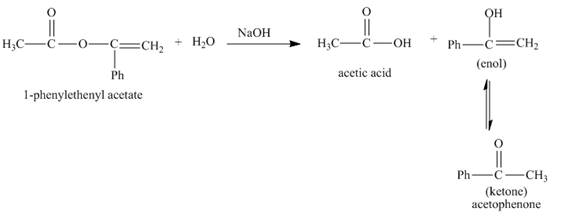
Explanation of Solution
The given incomplete reaction is shown below.

Figure 1
In the given reaction, the hydrolysis of ester takes place in the presence of base. The hydroxide ion of the sodium hydroxide reacts with the carbonyl carbon of the ester. The hysroxide group is a nucleophile which attacks at the electrophilic carbon. The hydrolysis of the ester gives acetic acid and enol. The enol tautomerises to form keto form. Both keto-enol co-exists in equilibrium. The complete reaction is shown below.
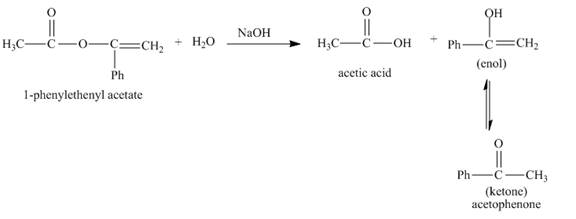
Figure 2
The complete given reaction with the products formed is shown in Figure 2.
(b)
Interpretation:
The given reaction is to be completed and product is to be shown.
Concept Introduction:
Trans esterification reaction is the reaction in which
Answer to Problem 21.54AP
The complete given reaction is shown below.
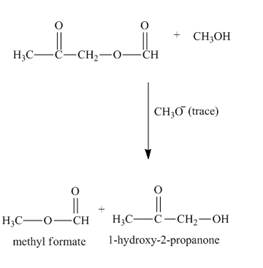
Explanation of Solution
The given incomplete reaction is shown below.

Figure 3
The
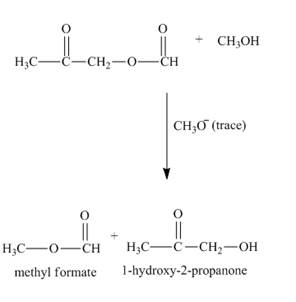
Figure 4
The complete reaction along with products formed is shown in Figure 4.
(c)
Interpretation:
The given reaction is to be completed and product is to be shown.
Concept Introduction:
Reaction of acid chloride with amine form amide compound. The phosgene reacts in similar way that of acid chloride with
Answer to Problem 21.54AP
The complete given reaction is shown below.

Explanation of Solution
The given incomplete reaction is shown below.

Figure 5
The lone pair of nitrogen of amine group attacks at the electrophilic carbonyl carbon of the phosgene. The chloride ion acts as leaving group and amide bond is formed. The amino group of

Figure 6
The complete reaction along with products formed is shown in Figure 6.
(d)
Interpretation:
The given reaction is to be completed and product is to be shown.
Concept Introduction:
Amide is formed in the reaction between acid chloride and amine. Hydrazine also reacts in same way. The hydrazine contains two amine groups, so it will reacts with the two equivalents of the acid chloride. Both the amine group of hydrazine gets acylated upon reaction with excess benzoyl chloride.
Answer to Problem 21.54AP
The complete given reaction is shown below.

Explanation of Solution
The given incomplete reaction is shown below.

Figure 7
The nitrogen atom of hydrazine acts as nucleophile and attacks at the carbonyl carbon of benzoyl chloride. It results in the formation of amide linkage. As, hydrazine posses two amine groups so the other amine group will also reacts with benzoyl chloride in the same way to form the desired product. The complete reaction is shown below.

Figure 8
The complete reaction along with products formed is shown in Figure 8.
(e)
Interpretation:
The given reaction is to be completed and product is to be shown.
Concept Introduction:
Amide group undergoes hydrolysis reaction in presence of an acid to form carboxylic acid and an amine. The nitrile group undergoes hydrolysis to form carboxylic acid and ammonia. The hydrolysis of nitrile takes place in strongly acidic medium.
Answer to Problem 21.54AP
The complete given reaction is shown below.

Explanation of Solution
The incomplete reaction is shown below.
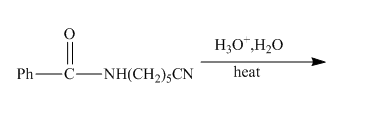
Figure 9
The hydrolysis of the amide bond takes place in acid or basic medium. The given compound in the presence of an acid will gert hydrolyzed. The hydrolysis of amide group forms amine and carboxylic acid. The hydrolysis of the nitrile group also takes place in strongly acidic medium to form carboxylic acid and ammonia. The given compound contains both amide and cyanide group, so both groups will get hydrolyzed. The resulting products will be acid, amino acid and ammonia. The complete reaction is shown below.

Figure 10
The complete reaction along with products formed is shown in Figure 10.
(f)
Interpretation:
The given reaction is to be completed and product is to be shown.
Concept Introduction:
Lactam is a cyclic amide compound. It will undergoes reduction reaction to form cyclic amine compounds. The reduction of lactam does not results in ring opening. Lithium aluminium hydride is used as the reducing agent. Imine intermediate is formed in the reduction of lactam.
Answer to Problem 21.54AP
The complete given reaction is shown below.

Explanation of Solution
The given incomplete reaction is shown below.
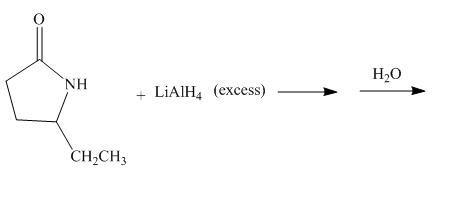
Figure 11
The lithium aluminium hydride is a strong reducing agent. It contains hydride ion which reacts with the carbonyl carbon. It will reduce the amide group to the amine group. The given compound is a lactam. The lactam will get reduced to cyclic amine. The reaction proceeds via cyclic imine intermediate. Cyclic imine intermediate is further reduced to the cyclic amine compound. The complete reaction is shown below.

Figure 12
The complete reaction along with products formed is shown in Figure 12.
(g)
Interpretation:
The given reaction is to be completed and product is to be shown.
Concept Introduction:
Grignard reagent reacts with esters to form tertiary alcohol. The reaction of lactone with grignard reagent also proceeds via same mechanism. The lactone is a cyclic ester compound. Lactone reacts with grignard reagent to form the dialcohol compound.
Answer to Problem 21.54AP
The complete given reaction is shown below.

Explanation of Solution
The given incomplete reaction is shown below.
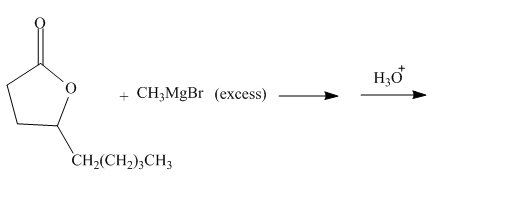
Figure 13
The carbonyl carbon of the lactone will undergo nucleophilic addition reaction with methyl magnesium bromide. The lactone will be coverted into the tertiary alcohol compound. Two equivalents of methyl magnesium bromide will react with the lactone to form the dialcohol product. The complete reaction is shown below.

Figure 14
The complete reaction along with products formed is shown in Figure 14.
(h)
Interpretation:
The given reaction is to be completed and product is to be shown.
Concept Introduction:
Grignard reagent reacts with esters to form tertiary alcohol. The reaction involves acyl substitution reaction which is followed by nucleophilic addition reaction. The reaction alkyl group of grignard reagent acts as the nucleophile and attacks at the carbonyl carbon of ester.
Answer to Problem 21.54AP
The complete given reaction is shown below.

Explanation of Solution
The given incomplete reaction is shown below.

Figure 15
The ethyl group of the ethyl magnesium bromide acts as nucleophile and attacks at the carbonyl carbon of the ester, which resuults in the formation of an ethyl ester with the removal of one

Figure 16
The complete reaction along with products formed is shown in Figure 16.
(i)
Interpretation:
The given reaction is to be completed and product is to be shown.
Concept Introduction:
Acid chloride reacts with lithium aluminium hydride to form alcohols. Lithium aluminium hydride is a strong reducing agent. The conversion of acid chloride into
Answer to Problem 21.54AP
The complete given reaction is shown below.

Explanation of Solution
The given incomplete reaction is shown below.

Figure 17

Figure 18
The complete reaction along with products formed is shown in Figure 18.
(j)
Interpretation:
The given reaction is to be completed and product is to be shown.
Concept Introduction:
Grignard reagent reacts with esters to form tertiary alcohol. The reaction involves acyl substitution reaction which is followed by nucleophilic addition reaction. The reaction alkyl group of grignard reagent acts as the nucleophile and attacks at the carbonyl carbon of ester.
Answer to Problem 21.54AP
The complete given reaction is shown below.

Explanation of Solution
The given incomplete reaction is shown below.

Figure 19
The given compound contains both the ester and aldehyde group. The grignard reagent reacts with both the groups, but if grignard reagent is taken in small amount then it will react with only the more reactive

Figure 20
The complete reaction along with products formed is shown in Figure 20.
(k)
Interpretation:
The given reaction is to be completed and product is to be shown.
Concept Introduction:
Trans esterification reaction is the reaction in which
Answer to Problem 21.54AP
The complete given reaction is shown below.
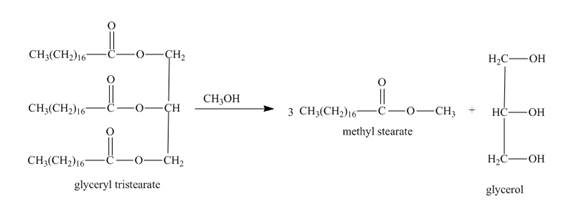
Explanation of Solution
The given incomplete reaction is shown below.

Figure 21
In this the glyceryl tristearate is a tri ester compound. In the presence of the methanol it will undergo transesterification reaction. The glyceryl tristearate reacts with methanol to form three equivalents of methyl stearate and one equivalent of glycerol. The complete reaction is shown below.

Figure 22
The complete reaction along with products formed is shown in Figure 22.
(l)
Interpretation:
The given reaction is to be completed and product is to be shown.
Concept Introduction:
Lactam are cyclic amide compound. It formed by the nucleophilic substitution reaction between the amine group and ester group present in the same molecule. Lactam undergoes reduction reaction to form cyclic amines. The nitrogen of amine group acts as nucleophilie and carbonyl carbon of ester acts as electriphilic centre.
Answer to Problem 21.54AP
The complete given reaction is shown below.

Explanation of Solution
The given incomplete reaction is shown below.

Figure 23
Esters on reaction with amine form amide compounds. As in the given compound the amine group and the ester group are present in the same molecule so upon reaction they will form cyclic amide compound known as lactam. The lone pair of nitogen atom attacks the carbonyl carbon of the ester to form the cyclic lactam with the elimination of alkoxy group. The complete reaction is shown below.

Figure 24
The complete reaction along with products formed is shown in Figure 24.
Want to see more full solutions like this?
Chapter 21 Solutions
Organic Chemistry Study Guide and Solutions
- Answe Answer A and B pleasearrow_forward3. Refer to the data below to answer the following questions: Isoelectric point Amino Acid Arginine 10.76 Glutamic Acid 3.22 Tryptophan 5.89 A. Define isoelectric point. B. The most basic amino acid is C. The most acidic amino acid is sidizo zoarrow_forward3. A gas mixture contains 50 mol% H2 and 50 mol% He. 1.00-L samples of this gas mixture are mixed with variable volumes of O2 (at 0 °C and 1 atm). A spark is introduced to allow the mixture to undergo complete combustion. The final volume is measured at 0 °C and 1 atm. Which graph best depicts the final volume as a function of the volume of added O2? (A) 2.00 1.75 Final Volume, L 1.50 1.25 1.00 0.75 0.50 0.25 0.00 0.00 0.25 0.50 2.00 (B) 1.75 1.50 Final Volume, L 1.25 1.00 0.75 0.50- 0.25 0.00 0.75 1.00 0.00 0.25 Volume O₂ added, L 2 0.50 0.75 1.00 Volume O₂ added, L 2 2.00 2.00 (C) (D) 1.75 1.75 1.50 1.50 Final Volume, L 1.25 1.00 0.75 0.50 Final Volume, L 1.25 1.00 0.75 0.50 0.25 0.25 0.00 0.00 0.00 0.25 0.50 0.75 1.00 0.00 0.25 Volume O₂ added, L 0.50 0.75 1.00 Volume O₂ added, L 2arrow_forward
- Leucine is an essential amino acid with the systematic name 2-amino-3-methylpentanoic acid. It has pai 2.36 and pKa2 = 9.60. H2N-C(R)H-COOH and R is -CH2-CH(CH3)2 A. Draw the condensed structure for leucine, and label all chirality centers with an asterisk. B. How many possible stereoisomers of leucine are there? C. Draw a Fischer projection of L-leucine and label the chirality center(s) as R or S. D. What is the p/ of leucine? E. Draw the structure of the predominant form of leucine at 10.00. F. Draw the structure of the predominant form of leucine at pH = 1.50. G. Leucine is described as an essential amino acid. What does this mean? H. Show the alkyl halide you would use to prepare leucine by the amidomalonate method. =arrow_forwarda) Write out 6 completely different reactions of acetophenone (reagent, product). b) Write out 3 preparations of 1-methylcyclohexanol, using a different starting material for each one. You may use preps where you just change the functional group, and/or preps where you construct the carbon chain. c) Write out 3 preparations of 2-ethoxybenzoic acid, a different starting material for each one. You may use preps where you just change the functional group, and/or preps where you construct the carbon chain.arrow_forward12. CH3 OH OH H&C CH3 H₂C N OH H₂C CH3 H&C CH3 H₂C' CH3 H.C CH3OH H.C CH2CH3OH CH3CEN Which one of these 17 compounds is represented by this IR and this 'H NMR spectrum? IR Spectrum 3000 4000 3000 NMR Spectrum 2000 £500 RAVENUMBER 2000 1500 9 8 6 5 10 HP-00-290 ppm m 1000 500 1000 4 °arrow_forward
- Draw the structure of (E,6R) 6-methoxy-4-hepten-2-one. Give the IUPAC name of this compound, including stereochemistry. Draw the most stable chair conformation of (cis) 1,3-isobutylcyclohexane. H HC=CCH₂ CH2CH3 EN(CH3)2 -CN(CH3)2arrow_forward10. Write out the mechanism (intermediate/transition state) for this reaction; indicate stereochemistry in product. H3C CH₂OH CH3 SN1 Harrow_forwardWrite "most" under the member of each trio which is most stable. Write "least under the member of each trio which is least stable. b) Draw a Fischer projection of a pair of enantiomers with three chiral carbons. Which of these two would you expect to be more soluble in water? Why? 1-butanol 1-heptanol Which of these two would you expect to have the higher boiling point? Why? hexyl methyl ether 1-heptanolarrow_forward
- Write "most" under the most acidic compound. Write "least" under the least acidic compound. OH NO₂ OCH3 Br 9. Compound X, C50H84F2, reacts with excess H2/Pd to give a C50H88F2 compound. How many rings are in X? How many double bonds are in X? Show your work.arrow_forward4. State whether these two are: a) the same molecule b) c) d) different compounds that are not isomers constitutional isomers diastereomers e) enantiomers CH3 CH₁₂ H OH HO H H OH HO H CH, CH₂ 5. a) How many stereocenters does this compound have? b) How many stereoisomers are possible for this compound? CH₂ OH CHCHarrow_forwardCalculating the pH at equivalence of a titration A chemist titrates 210.0 mL of a 0.1003 M hydrobromic acid (HBr) solution with 0.7550M KOH solution at 25 °C. Calculate the pH at equivalence. Round your answer to 2 decimal places. Note for advanced students: you may assume the total volume of the solution equals the initial volume plus the volume of KOH solution added. pH = ] ☑ o0o 18 Ararrow_forward
 ChemistryChemistryISBN:9781305957404Author:Steven S. Zumdahl, Susan A. Zumdahl, Donald J. DeCostePublisher:Cengage Learning
ChemistryChemistryISBN:9781305957404Author:Steven S. Zumdahl, Susan A. Zumdahl, Donald J. DeCostePublisher:Cengage Learning ChemistryChemistryISBN:9781259911156Author:Raymond Chang Dr., Jason Overby ProfessorPublisher:McGraw-Hill Education
ChemistryChemistryISBN:9781259911156Author:Raymond Chang Dr., Jason Overby ProfessorPublisher:McGraw-Hill Education Principles of Instrumental AnalysisChemistryISBN:9781305577213Author:Douglas A. Skoog, F. James Holler, Stanley R. CrouchPublisher:Cengage Learning
Principles of Instrumental AnalysisChemistryISBN:9781305577213Author:Douglas A. Skoog, F. James Holler, Stanley R. CrouchPublisher:Cengage Learning Organic ChemistryChemistryISBN:9780078021558Author:Janice Gorzynski Smith Dr.Publisher:McGraw-Hill Education
Organic ChemistryChemistryISBN:9780078021558Author:Janice Gorzynski Smith Dr.Publisher:McGraw-Hill Education Chemistry: Principles and ReactionsChemistryISBN:9781305079373Author:William L. Masterton, Cecile N. HurleyPublisher:Cengage Learning
Chemistry: Principles and ReactionsChemistryISBN:9781305079373Author:William L. Masterton, Cecile N. HurleyPublisher:Cengage Learning Elementary Principles of Chemical Processes, Bind...ChemistryISBN:9781118431221Author:Richard M. Felder, Ronald W. Rousseau, Lisa G. BullardPublisher:WILEY
Elementary Principles of Chemical Processes, Bind...ChemistryISBN:9781118431221Author:Richard M. Felder, Ronald W. Rousseau, Lisa G. BullardPublisher:WILEY





